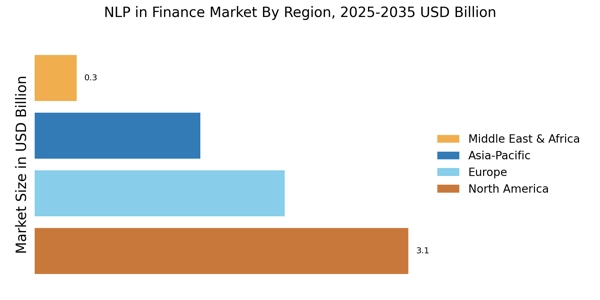The NLP in Finance Market is currently characterized by a dynamic competitive landscape, driven by rapid technological advancements and an increasing demand for data-driven decision-making. Major players such as Google (US), IBM (US), and Microsoft (US) are at the forefront, leveraging their extensive resources to innovate and enhance their offerings. Google (US) focuses on integrating advanced machine learning algorithms into its financial services, while IBM (US) emphasizes its Watson platform to provide tailored solutions for risk management and compliance. Microsoft (US) is strategically positioning itself through partnerships with financial institutions to enhance its Azure cloud services, thereby facilitating seamless data processing and analytics. Collectively, these strategies not only bolster their market presence but also intensify competition, as they vie for leadership in a sector that is increasingly reliant on sophisticated NLP technologies.
In terms of business tactics, companies are adopting various approaches to optimize their operations and enhance market penetration. For instance, localizing services to meet regional regulatory requirements and optimizing supply chains for efficiency are becoming prevalent strategies. The market structure appears moderately fragmented, with a mix of established giants and emerging startups. This fragmentation allows for diverse innovations, yet the collective influence of key players like Google (US) and IBM (US) tends to dominate the competitive dynamics, shaping industry standards and customer expectations.
In August 2025, Google (US) announced the launch of its new NLP-driven analytics tool specifically designed for financial forecasting. This tool aims to provide financial analysts with predictive insights by analyzing vast datasets in real-time. The strategic importance of this development lies in its potential to enhance decision-making processes within financial institutions, thereby solidifying Google’s position as a leader in the NLP space. By offering such advanced capabilities, Google (US) not only addresses the growing need for accurate forecasting but also sets a benchmark for competitors.
In September 2025, IBM (US) unveiled a partnership with a leading global bank to implement its AI-driven compliance solution. This collaboration is particularly noteworthy as it highlights IBM's commitment to addressing regulatory challenges faced by financial institutions. The strategic significance of this partnership lies in its potential to streamline compliance processes, reduce operational risks, and enhance the bank's overall efficiency. Such alliances may also pave the way for further innovations in the compliance sector, reinforcing IBM's reputation as a trusted partner in the financial services industry.
Moreover, in October 2025, Microsoft (US) expanded its Azure cloud services by integrating advanced NLP capabilities tailored for investment analysis. This move is indicative of Microsoft's strategy to enhance its cloud offerings, making them more appealing to financial analysts and investment firms. The integration of NLP into Azure not only improves data processing capabilities but also positions Microsoft (US) as a formidable competitor in the financial technology landscape, where speed and accuracy are paramount.
As of October 2025, the competitive trends in the NLP in Finance Market are increasingly defined by digitalization, sustainability, and the integration of AI technologies. Strategic alliances among key players are shaping the landscape, fostering innovation and collaboration. Looking ahead, it appears that competitive differentiation will evolve, with a pronounced shift from traditional price-based competition to a focus on innovation, technological advancements, and supply chain reliability. This evolution suggests that companies that prioritize these aspects will likely gain a competitive edge in the rapidly changing financial market.


















Leave a Comment